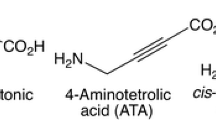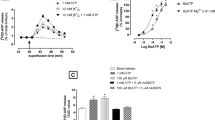Abstract
The effects of endogenous and synthetic peptides containing GABA or its analogues on the GABA/benzodiazepine/chloride ionophore, complex, GABAB receptor, Cl fluxes, GABA release and GABA uptake were studied using synaptic membranes, crude synaptoneurosomal preparations and slices prepared from the rat and mouse brain. The sodium-independent binding of GABA was strongly inhibited by GABA-histidine, followed by γ-glutamyl-homotaurine, GABA-glycine and γ-glutamyl-GABA. The binding of diazepam was slightly enhanced by the same peptides. The peptides alone had no effect on the chloride fluxes, but GABA-histidine, γ-glutamyl-GABA and GABA-glycine enhanced while γ-glutamyl-homotaurine and GABA-taurine inhibited GABA-stimulated chloride uptake. GABA-histidine was the most effective displacer of baclofen binding, but γ-glutamyl-homotaurine was entirely ineffective. The uptake of GABA was markedly inhibited in synaptosomal preparations by GABA-histidine, while all other peptides were less effective. γ-Glutamyl-taurine attenuated but γ-glutamyl-homotaurine and GABA-glycine enhanced the potassium-stimulated release of GABA. The present actions of GABA-histidine in vitro may be of significance for GABAergic neurotransmission in vivo.
Similar content being viewed by others
References
Sano, I., Kakimoto, Y., Kanazawa, A., Nakajima, T., andSchizimu, M. 1966. Identifizierung einiger Glutamyl Peptide aus Gehirn. J. Neurochem. 13:711–719.
Reichelt, K. L., and Edminson, P. D. 1977. Peptides containing probable transmitter candidates in the central nervous system. Pages 171–181,in Gainer H. (ed.) Peptides in Neurobiology, Plenum Press, New York.
Török, K., Varga, V., Somogyi, J., Feuer, L., and Gulyás, J. 1981. Formation of γ-glutamyl-taurine in the rat brain. Neurosci. Lett. 27:145–149.
Lähdesmäki, P., and Marnela, K.-M. 1984. Glutamyl-, aspartyl-and seryl-taurines a group of brain peptides. Acta Univ. Tamp. [B] 21:78–84.
Pisano, J. J., Wilson, J. D., Cohen, L., Abraham, D., and Udenfriend, S. 1961. Isolation of γ-aminobutyrylhistidine (homocarnosine) from brain. J. Biol. Chem. 236:499–502.
Abraham, D., Pisano, J. J., and Udenfriend, S. 1962. The distribution of homocarnosine in mammals. Arch. Biochem. Biophys. 99:210–213.
Margolis, F. L. 1974. Carnosine in the primary olfactory pathway. Science 184:909–911.
Neidle, A., and Kandera, J. 1974. Carnosin, e-an olfactory bulb peptide. Brain Res. 80:359–364.
Jones, A. W., Smith, D. A. S., and Watkins, J. C. 1984. Structure-activity relations of dipeptide antagonists of excitatory amino acids. Neuroscience 13:573–581.
Fagg, G. E. 1985.l-Glutamate, excitatory amino acid receptors and brain function. Trends Neurosci. 8:207–210.
Varga, V., Marnela, K.-M., Kontro, P., Gylyás, J., Vadász, Z., Lähdesmäki, P., and Oja, S. S. 1987. Effects of acidic dipeptides on aminoacidergic neurotransmission in the brain. Pages 357–368,in Huxtable, R. J., Franconi, F. and Giotti, A. (eds), The Biology of Taurine. Methods and Mechanisms, Plenum Press, New York.
Zukin, S. R., Young, A. B., and Snyder, S. H. 1974. Gammaaminobutyric acid binding to receptor sites in the rat nervous system. Proc. Natl. Acad. Sci. USA 71:4802–4807.
Whittaker, V. P., and Barker, L. A. 1972. The subcellular fractionation of brain tissue with special reference to the preparation of synaptosomes and their component organelles. Pages 1–52,in Fried, R. (ed.), Methods of Neurochemistry, Vol. 2, Marcel Dekker, New York.
DeFeudis, F., Ossola, L., Maitre, M., Elkouby, A., Roussel, G., and Mandel, P. 1979. Comparison of high-affinity binding of [3H]-GABA to subcellular particles of rat brain and liver. Neurochem. Res. 4:365–376.
Tallman, J. F., Thomas, J. W., and Gallager, D. W. 1978. TABAergic modulation of benzodiazepine binding site sensitivity. Nature 274:383–385.
Hill, D. R., and Bowery, N. G. 1981. [3H]-Baclofen and [3H]-GABA bind to bicuculline-insensitive GABAB sites in rat brain. Nature 290:149–152.
Allan, A. A., and Harris, R. A. 1986. γ-Aminobutyric acid agonists and antagonists alter chloride flux across brain membranes. Mol. Pharmacol. 29:497–505.
Kontro, P. 1984. Synaptosomal hypotaurine and GABA transport by a single system. Mol. Physiol. 6:331–338.
Kontro, P., and Oja, S. S. 1978. Taurine uptake by rat brain synaptosomes. J. Neurochem. 30:1297–1304.
Korpi, E. R., and Oja, S. S. 1984. Comparison of two superfusion systems for study of neurotransmitter release from rat cerebral cortex slices. J. Neurochem. 43:236–242.
Oja, S. S., and Kontro, P. 1987. Cation effects on taurine release from brain slices: comparison to GABA. J. Neurosci. Res. 17:302–311.
Korpi, E. R., and Oja, S. S. 1979. Efflux of phenylalanine from rat cerebral cortex slices as influenced by extra- and intracellular amino acids. J. Neurochem. 32:789–796.
Snedecor, G.W. 1959. Statistical Methods, 5th edn., Iowa State College Press, Ames.
Nistri, A., Constanti, A., and Krnjević, K. 1980. Electrophysiological studies of the mode of action of GABA on vertebrate central neurons. Pages 81–90,in Pepeu, G., Kuhar, M. J., and Enna, S. J. (eds.), Advances in Biochemical Psychopharmacology, Vol. 21: Receptors for Neurotransmitters and Peptide Hormones, Raven Press, New York.
Olsen, R. W. 1981. GABA-benzodiazepine-barbiturate receptor interactions. J. Neurochem. 37:1–13.
Karobath, M., and Sperk, G. 1979. Stimulation of benzodiazepine receptor binding by γ-aminobutyric acid. Proc. Natl. Acad Sci. USA 76:1004–1006.
Braestrup, C., Nielsen, M., Krogsgaard-Larsen, P., and Falch, E. 1979. Partial agonists for brain GABA/benzodiazepine receptor complex. Nature 280:331–333.
Krogsgaard-Larsen, P., and Johnston, G. A. R. 1978. Structure-activity studies on the inhibition of GABA binding to rat brain membranes by muscimol and related compounds. J. Neurochem. 30:1377–1382.
Krogsgaard-Larsen, P., Hjeds, H., Curtis, D. R., Lodge, D., and Johnston, G. A. R. 1979. Dihydromuscimol, thiomuscimol and related heterocyclic compounds as GABA analogues. J. Neurochem. 32:1717–1724.
Honoré, T., Hjeds, H., Krogsgaard-Larsen, P., and Christiansen, T. R. 1978. Syntheses and structure-activity studies of analogues of γ-aminobutyric acid (GABA). Eur. J. Med. Chem. 13:429–434.
Galzigna, L., Bianchi, M., Bertazzon A., Barthez A., Quadro, G., and Coletti-Previero, M. A. 1984. An N-protected γ-aminobutyric acid dipeptide, with anticonvulsant action. J. Neurochem. 42:1762–1766.
Michaud, J. C., Mienville, J. M., Chambon, J. P., and Biziére, K. 1986. Interactions between three pyridazinyl-GABA derivatives and central GABA and glycine receptors in the rat, an in vivo, microiontophoretic study. Neuropharmacology 25:1197–1203.
Levi, G. 1984. Release of putative transmitter amino acids. Pages 463–509in Lajtha, A. (ed.) Handbook of Neurochemistry, Vol. 6, 2nd ed., Plenum Press, New York.
Kalsner, S. 1985. Is there feedback regulation of neurotransmitter release by autoreceptors? Biochem. Pharmacol. 34:4085–4097.
Kontro, P., and Oja, S. S. 1987. Taurine and GABA release from mouse cerebral cortex slices: effects of structural analogues and drugs. Neurochem. Res. 12:475–482.
Ng, R. H., and Marshall, F. D. 1978. Regional and subcellular distribution of homocarnosine-carnosine synthetase in the central nervous system of rats. J. Neurochem. 30:187–190.
Author information
Authors and Affiliations
Rights and permissions
About this article
Cite this article
Varga, V., Kontro, P. & Oja, S.S. Modulation of GABAergic neurotransmission in the brain by dipeptides. Neurochem Res 13, 1027–1034 (1988). https://doi.org/10.1007/BF00973146
Accepted:
Issue Date:
DOI: https://doi.org/10.1007/BF00973146




